Uttarakhand Floods: The Calamity That Caused a Bedlam
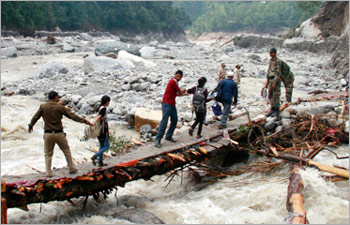
June 28, 2013: The Kedarnath valley by the Mandakini River is a haunted island today. There is an eerie silence and the stink of rotting bodies fills the area once bustling with nearly 10,000 people at any given point of time.
On that morning of June 16, the fury of floods left behind a trail of devastation in this temple valley. The epicentre of this calamity was Vasukital, a glacial lake at an altitude of 14,200 feet where a cloudburst occurred past the midnight of June 16. It led to overflowing of the lake causing flash floods down the hills in Kedarnath.
Thousands of people and many structures, including the Shankaracharya memorial, were washed away without a trace while the lodges and food stalls around the temple were filled with slush.
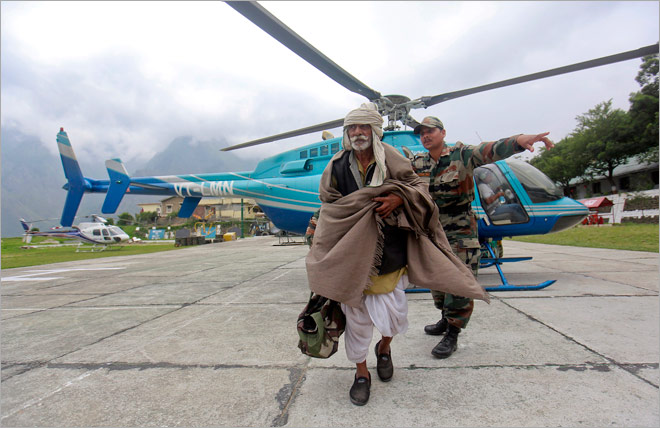
Today, what remains are collapsed shops and lodges and boulders brought down by the deluge strewn all across the valley and some strange-looking sadhus.
These saffron-clad men have literally tried to cash in on the biggest disaster the state has ever faced.
In fact, the National Disaster Response Force (NDRF) has recovered over Rs.one crore in cash from these sadhus in the Kedarnath region.
"We suspect the money (Rs.1,14,83,000) primarily came from the SBI branch in Kedarnath. But looking at some coiled notes, we can't rule out looting of bodies," says NDRF IG Sandeep Rathore.
They also recovered an SLR rifle from a sadhu. "It perhaps belongs to the local police station," Rathore said.
Amid all this stands tall the Kedarnath shrine -- a stone edifice. The temple bell, the 'shivling' and the sanctum sanctorum and other idols are safe though buried in several feet of mud and silt.
The silence is often broken by the sound of IAF choppers, NDRF troops scouting for survivors and journalists taking stock of the situation. The survivors recount how they saw people, their belongings, cattle and even LPG cylinders being swept away by the ravaging water.
This story of devastation was repeated everywhere in 40,000 square km of flood-affected area in the four districts of Uttarakhand - Rudraprayag, Uttarkashi, Pithoragarh and Chamoli.
With flash floods and incessant and torrential rain washing away roads at around 100 places, nine major bridges and nearly hundred small bridges, over 3,000 building and housing structures and around 2,000 vehicles, pilgrims and tourists were left stranded at many places across the state.
With road network washed away at many places, the armed forces set up rescue camps across the state.
One such camp is the Harsil military base on the banks of the Bhagirathi and 74 km from Uttarkashi.
Around 6,000 people descending from Gangotri and other areas camped here. The Garhwal battalions of the Army have turned their barracks into a temporary camp for stranded tourists.
From Harsil military base, 7,680 feet above sea-level, some pilgrims were sent on choppers to Dharasu and Uttarkashi and Dehradun while others are encouraged to trek down a 30-km temporary road built by the Border Roads Organisation.
When India Today visited Harsil, there were around 500 people in the relief camp. The district administration is conspicuous by its absence while the Garhwal Rifles is providing shelter, food and medicine not only to people waiting for evacuation but also to adjoining villages.
The BRO personnel, working round-the-clock to build temporary roads, have two goals in mind -- to reduce the pressure on aerial evacuation and ensure that the locals can get supply of rations.
The devastation around the villages in Harsil is stark and even temples could not survive the water's fury.
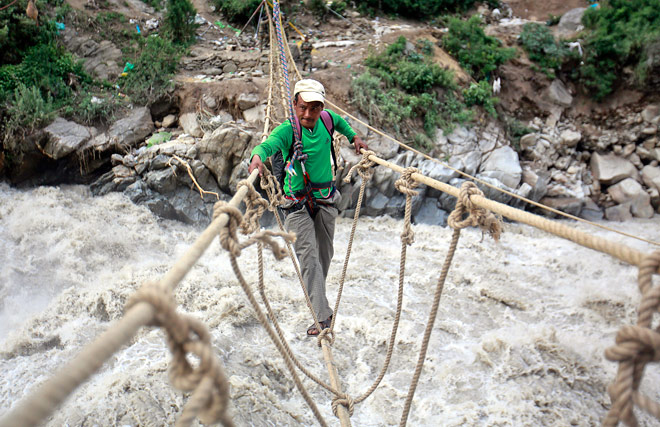
Between Harsil and Gangotri, we saw five temples, one 20 feet high, submerged in silt. All the guest houses and shops lining this stretch have either vanished or are covered in mud and slush.
In the villages, several homes near the Bhagirathi have knee-deep mud inside. The casualties here have been minimal but livelihood has been hit hard.
With no possibility of tourist inflow to these areas, at least for a year, a dark future looms for many whose primary income was tourism.
Some are trying to start life afresh, opening tea stalls in the open and recounting days when business ran almost 24X7.
The locals in the villages now face starvation as they have lost connectivity with the rest of the world. The flood waters destroyed the granary of many families. Yet the people of Bhagori, a small village next to the military helipad in Harsil, have gone out of their way to start a community kitchen and feed pilgrims and tourists stranded at the helipad.
For any Hindu devotee seeking nirvana, the holy city of Rishikesh, on the banks of the Ganga, is a spiritual gateway. But the idea of tranquility is shattered at the bus terminus of the town - blowing horns, screaming conductors, client-chasing vendors and hundreds of travellers converging in an area of 200 square metres.
Today, the terminus has turned into a mirror of the unimaginable tragedy the flood unleashed on the four districts.
Gaurav Singh, a 25-year-old software engineer from Aligrah, suddenly breaks down at the bus stop littered with food leftovers, water bottles, papers and animal excreta.
Used to natty dressing and working in an air-conditioned environment in Kleward in Noida, Singh is today unmindful of the dirt he sits on. His blue T-shirt stinks and khaki trousers are torn.
But nobody notices him as he screams in pain and desperation, pulls his hair and thumps his chest.
It's already 6.30 pm and there may not be any more buses coming from the ravaged hills.
For five days, he has stationed himself at the bus stand, scanning every vehicle that was bringing the stranded victims from Kedarnath valley, washed away on the morning of June 16.
The night before, his parents had called on his mobile phone speaking about their successful visit to Kedarnath. But since then, his attempts to reach them over the phone end in a recorded voice: "The dialed number is switched off".
Five days of frantic search, hundreds of calls to various officials and monitoring news channels beamed on a public screen at the bus stand have been futile.
A stranger, together in this Himalayan calamity, offers Singh water and a hand.
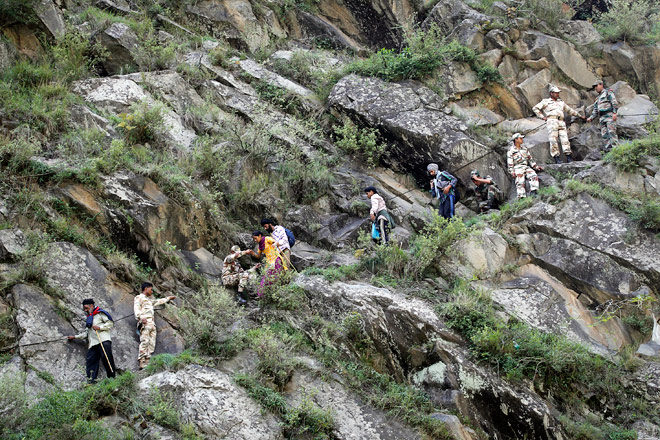
With the other hand, he is holding the photographs of his wife and two children missing from Kedarnath since June 16.
Singh holds his hands, wipes his tear and runs to scan the bus that had just reached.
But the young professional's faith in divine powers is lost forever.
"What was my parent's crime? What's my crime that I have to face this?" Singh asks before retreating to a corner of the terminus where he rests on a cardboard.
The wait has been testing his stamina as the 25-year-old is on his feet for the entire day.
Singh is not alone. Whenever a bus or small jeeps reach the terminus with rescued victims, waiting relatives surround the vehicle to see if their near and dear ones are there.
If not, they show the photographs asking the tired and traumatised victims if they had seen the people somewhere.
The relief of rescue is met with the desperation of search.
The routine continues for the whole day. When no information is found about the relatives, people break down in despair or cry silently. In minutes, they get ready to scan the next vehicle.
In their collective grief and search, these people are alone as the Uttarakhand government machinery is conspicuous by its absence.
There is no government official at the Rishikesh bus station. Only some voluntary organisations have organised medical help, food and resting area for the rescued victims here.
Various state governments have parked their buses that take the victims to their homes.
A journalist at a local daily took the role of a public announcer telling the restless people about the arrival and departure of vehicles.
Frustrated at the number of the questions thrown at him as he was the only face in a missing rescue management, he made an announcement: "If there is any BSNL official here, please stop doing business with victims. We assumed these helpline numbers would be toll-free, but you people are charging money. Please stop this."
A middle-aged man, who is waiting for a word for his wife, shouted: "I'm ready to pay, but these numbers don't work."
The willingness to pay or lack of it determined the fate of several pilgrims stranded in the mountains.
After spending two days in a jungle near Gaurigaon, a hamlet over Gaurikund, 40-year-old Kanpur businessman Sudhir Kumar Gupta's joy knew no bounds when he saw a chopper landing at the newly-built helipad. But his happiness was short-lived as after queuing up for four days and waking up at midnight, Gupta could not board a chopper.
"The local police took bribes of up to Rs.1,000 to put you on the chopper. The armed forces had not reached then. Even the local doctor issued certificates saying a person was sick for Rs.500. After four days, I was fed up. Along with around 500 others, I decided to trek down," says Gupta who exhausted all the cash he had in buying Fruti for Rs.200 and a packet of biscuit for Rs.250.
"In Fata, I was kicked by Uttarakhand Police official when I tried to board a chopper. They give preference to only VIPs and those with cash," says Ram Singh Tiwari, a 62-year-old a pan shop owner from Rai Bareilly, who lost his grandson in the deluge that swept through the Kedarnath temple.
Sugandh Chand Jain, a 55-year-old government employee from Gotegaon in Madhya Pradesh, is still waiting for his in-laws to return from Badrinath.
Jain's entire family - including his wife, son, daughter-in-law and four members of his in-laws, had lined up at the helipad in Badrinath.
Uttarakhand Police, who demanded bribes, did not allow the Jains too to board the chopper.
After four days of waiting, Jain and his son managed to reach to an army jawan who helped them get in touch with IAF officers who later put them in the chopper.
But his in-laws, who were 13 slots behind them in the queue, were left behind.
While the government is missing in action, except in finding newer ways to harass people, private initiatives have shown extraordinary commitment to the distressed.
The road to Joshimath via Rudraprayag is lined by roadside stalls stocking biscuits, chana, water, rusks, fruits and packaged juice.
Opened by socio-religious groups, local clubs and NGOs, these stalls are managed by volunteers who wait by the road all day braving rains.
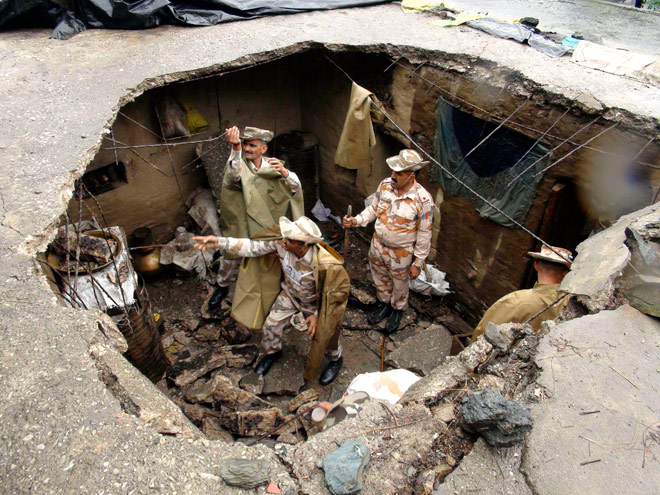
They stop vehicles going up the hills requesting the passengers to handover these items to anyone in need.
When India Today travelled on this road, it spotted at least 30 such stalls in the 140 km stretch between Rishikesh and Rudraprayag.
Even the locals who themselves suffered the calamity went beyond their means to offer help and shelter to the tourists stranded in the mountains.
Several rescued victims have recounted how villagers in Harsil, Uttarkashi, Badrinath, Gaucher and Chamoli shared their dwindling ration with the pilgrims.
"The local people of Bagori village near Harsil ran out of their stock as the road beyond Uttarkashi had collapsed and government relief materials never reached them. Yet they shared everything they had. One plate of khichdi were shared by at least 50 people," says Vijay Kumar, a 55-year-old homeopath from Madhubani in Bihar.
Then there are some good Samaritans who had to negotiate government apathy to make help reach the victims.
Professor D.C. Srivastava and his wife Amita Srivastava from IIT Roorkie reached Dehradun with 1,000 water bottles, 1,500 packets of matthi and 1,200 packets of shakarpara.
"We did not know who to approach. The officials of the disaster management department had no clue about the mechanism to send these materials to the victims. So we met the Jolly Grant Airport manager who promised that he would hand over these items to IAF," says Amita.
Dehradun-based Major General (Retd) C. Nandwal, whose friend Anil Agarwal has a dharamshala in the state capital, reached Sahashradhara helipad on June 23 to offer free food and accommodation to victims.
But he found no official at the helipad who could guide him on the state government's mechanism to take relief materials to the stranded victims.
When he insisted on meeting a senior official, a constable took down his number and said they would get back to him.
Frustrated, the general asked if he could place a banner showing his contact info only to get a curt reply: "Kahi bhi lagao".
The same happened with Ashwini Kumar Sharma, a trained volunteer from Bhopal who rushed to Dehradun to offer his help. Despite zero cooperation from officials at Sahajdhara helipad, Sharma is taking care of the victims brought to the spot. He makes them call their homes, ensure they receive medical attention on the spot and reach their destinations.
The helipad is a glaring example of a clueless government messing up relief operations. At one corner of the resting area meant for victims brought by private choppers to the helipad lie unattended loads of relief materials and food items sent by various groups and individuals.
Nobody has a clue how to send these materials to the people who need them most.
When reporters pointed out why these things were not taken to the affected areas, a policeman deployed to help the relief operations replied: "We don't have orders from the top."
And finding "top" officials here is almost next to impossible.
The officials are to be spotted at the helipad only when there are some VIP movements.
Many people at the helipad complained to me that a lot of relief material dropped from the chopper have either reached the wrong people or washed away in the water.
"In Gaucher some local people were selling Fruti packets for Rs.500. This was meant for us but dropped at the wrong place," says Ajay Mittal, a businessman from Delhi.
Captain Naren Diwekar, who is flying a Bel 407 helicopter hired by the Chhattisgarh government, admits that such things have happened.
"There are slopes in hills and many victims do a foolish thing. Out of fear, they hide in jungles up in the hill where it's impossible to spot. So relief material may go into wrong hands," he said.
On June 22, one such VIP, Planning and IT Minister Dinesh Agarwal, had to face the anger of the distressed people waiting for their missing relatives.
Agarwal, who wanted to do an aerial survey, was heckled by irate public who had so many questions for the government. The minister had to beat a hasty retreat as he had no convincing answer for them.
Along with the minister, the DM of Dehradun (Rural) also disappeared. That was his first visit to the helipad.
Even for those involved in rescue operations, VIP movements have come as unwanted intervention.
One top civil aviation official, whose phone has not stopped ringing ever since rescue operations started, gave a mouthful to a state minister who was stuck in Kedarnath on June 24.
"Did I tell you to go there? I can't send one special chopper for you when all the choppers are flying to Harsil and Badrinath today," said the exasperated officer.
He had reasons to be annoyed. Just an hour ago, Rahul Gandhi had left the airport and as and when he was talking to the Uttarakhand minister, the Maharashtra Chief Minister had alighted from a chopper.
Another person allergic to VIPs is Captain Naren Diweker, who is part of the rescue team sent by the Chhattisgarh Government.
Annoyed with "the tamasha that rescue operations have become", Diwekar bluntly ignored requests for chopper rides from politicians and journalists.
"If you are meeting me for a sortie, stay away from me. For your story, I can't block two seats as every life stranded out there is precious," Diwekar screamed at a TV reporter who wanted an aerial trip in his Bel 407.
The commitment to his job, however, is intact as the 47-year-old pilot gets restless to fly even though the sky refuses to clear.
His deputy, Ashfaq Ghouri, says local people stand next to choppers and get photographed. "Is this some kind of a mela? It's a heart-breaking human tragedy and we are here to save lives, not to entertain people," says Ghouri.
"The Patnjali group and Siromani Akali Dal have opened two stalls to offer food to the rescued people. Most of the time, unwanted people thronging the place are eating that food. It betrays the main purpose behind these stalls," says Diwekar.
He, in fact, summarises the Uttarakhand government's approach towards the rescue and relief operations - a clueless and indifferent government betraying the Herculean rescue operations by the armed forces, Indo-Tibetan Borer Police (ITBP) and NDRF complimented by generous tales of individual empathy.
Source: India Today, DT. June 28, 2013.







